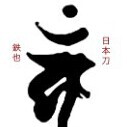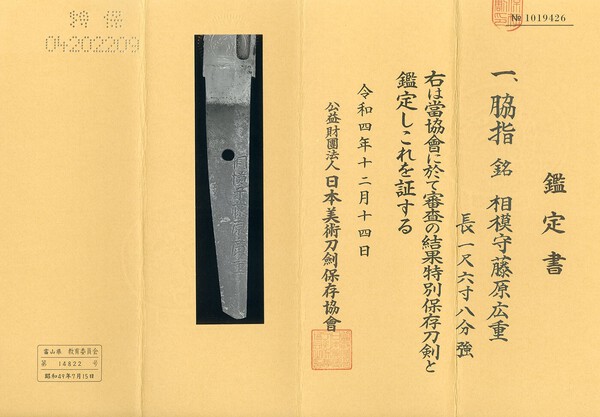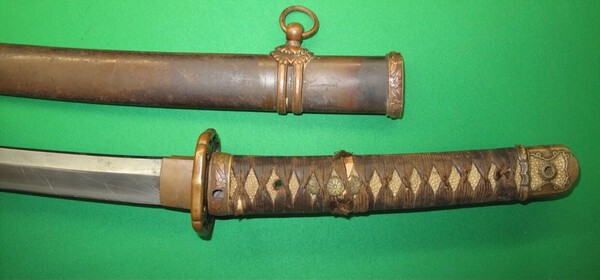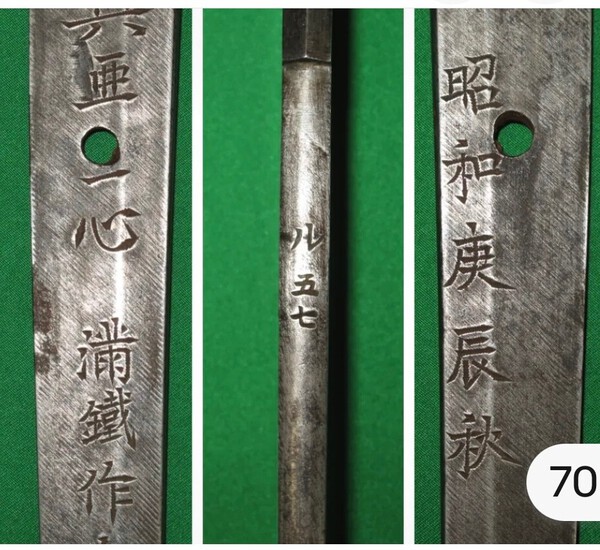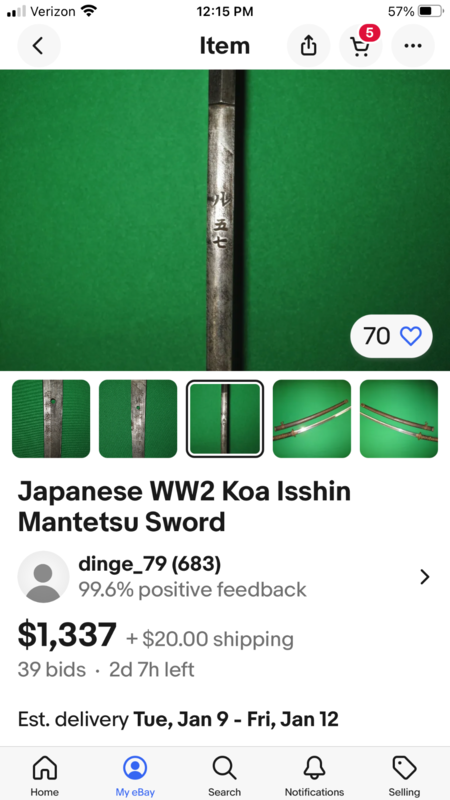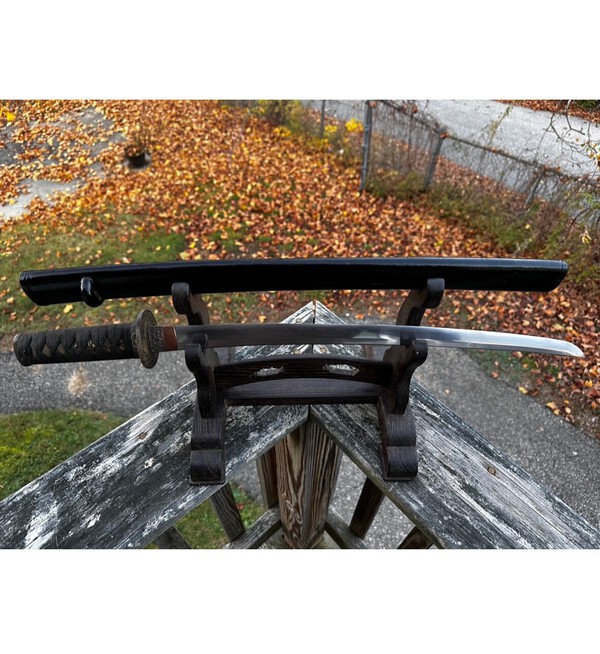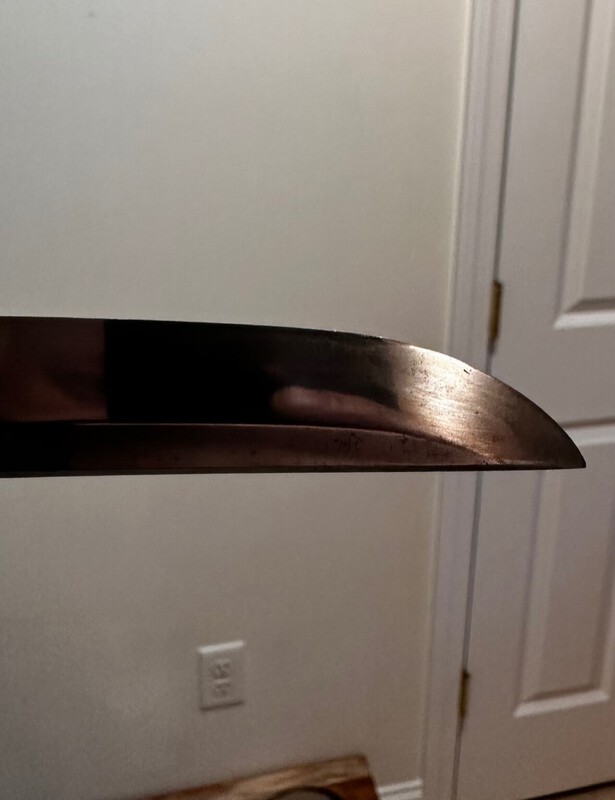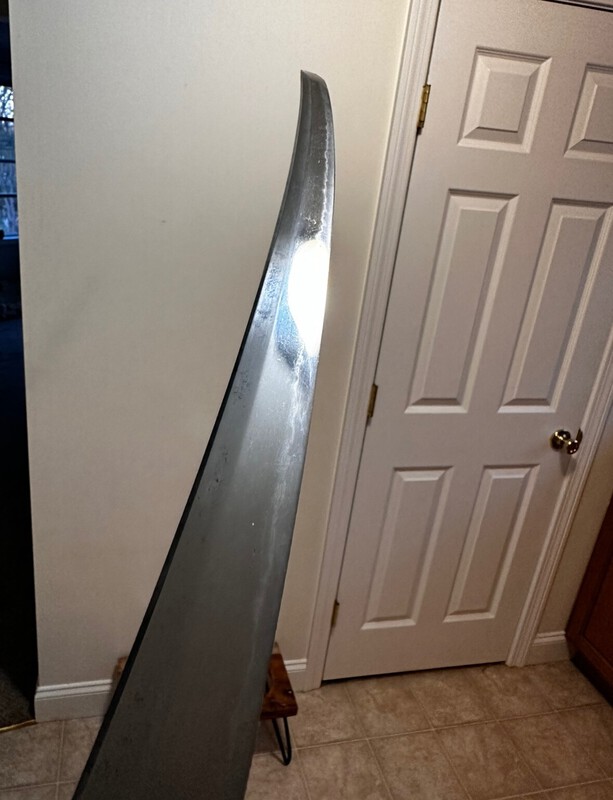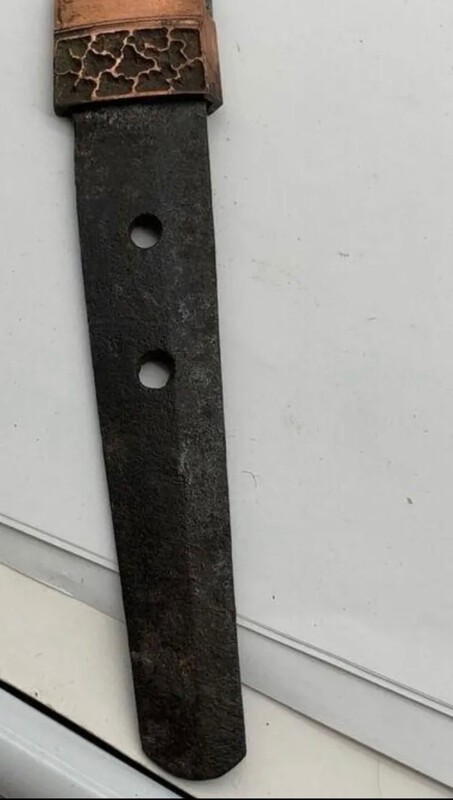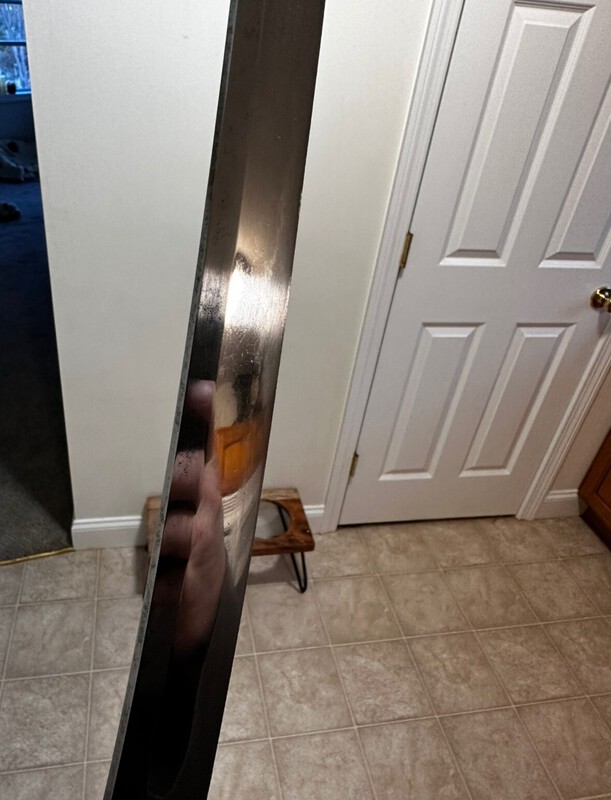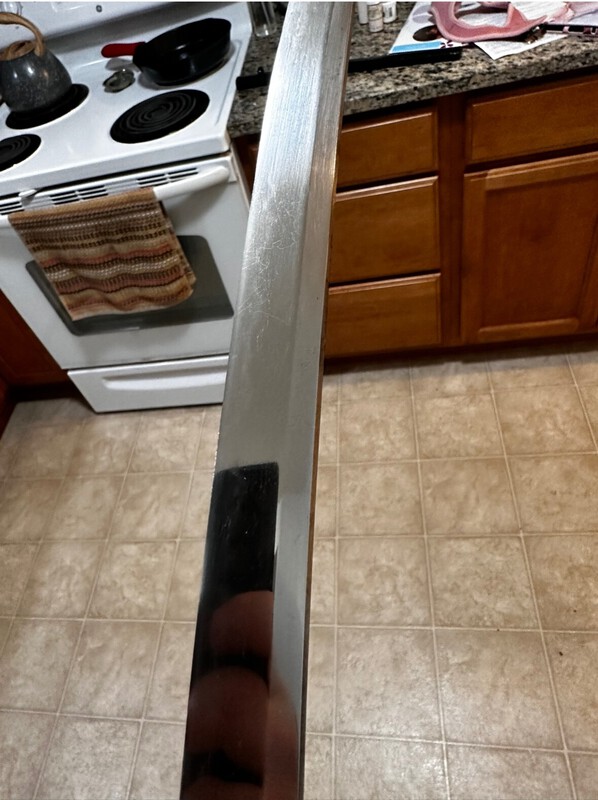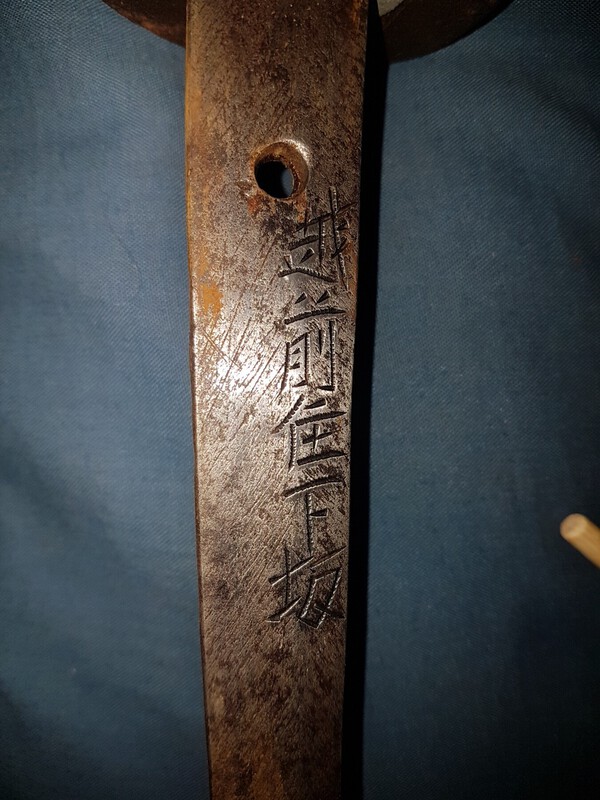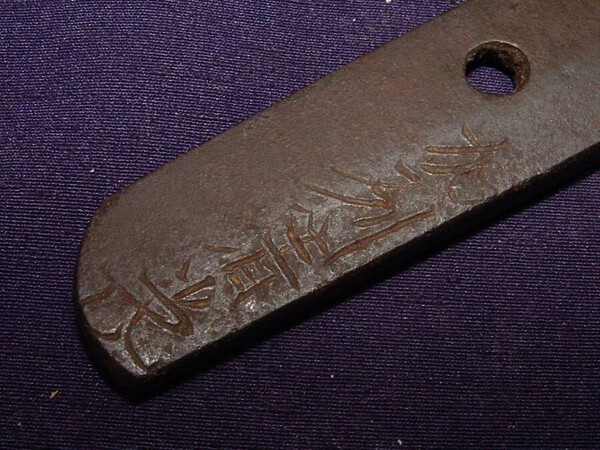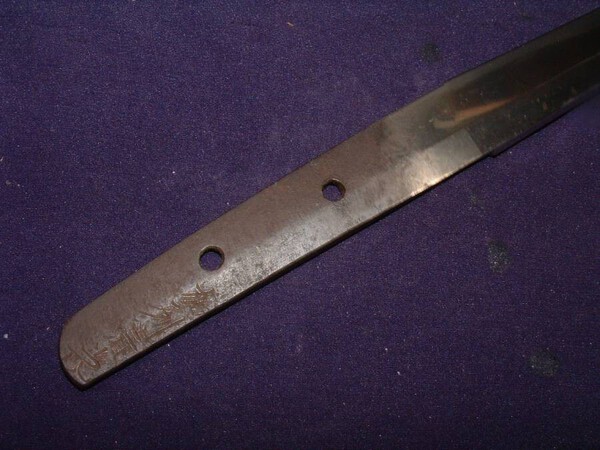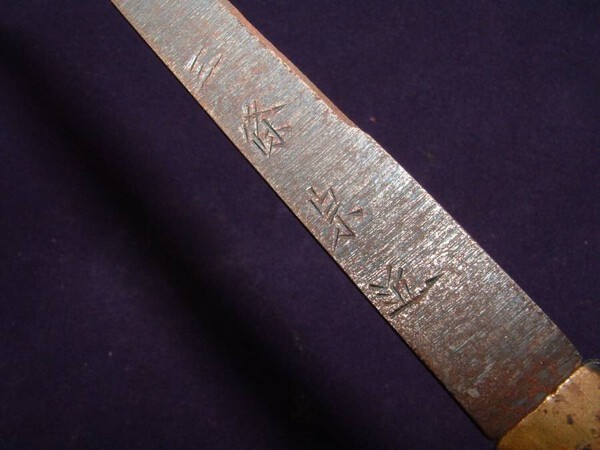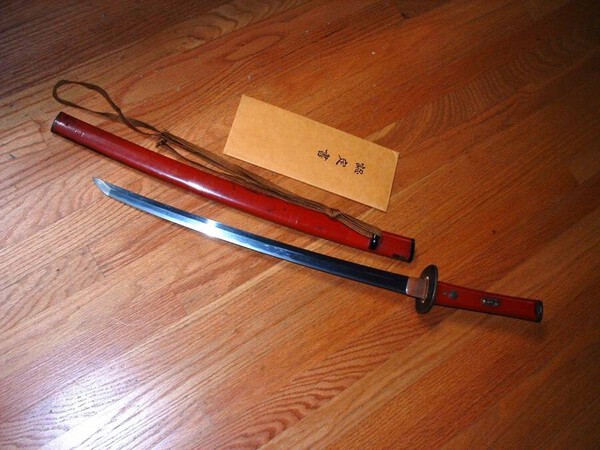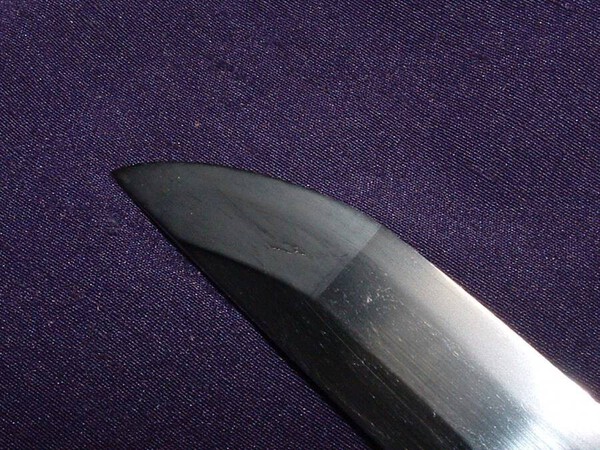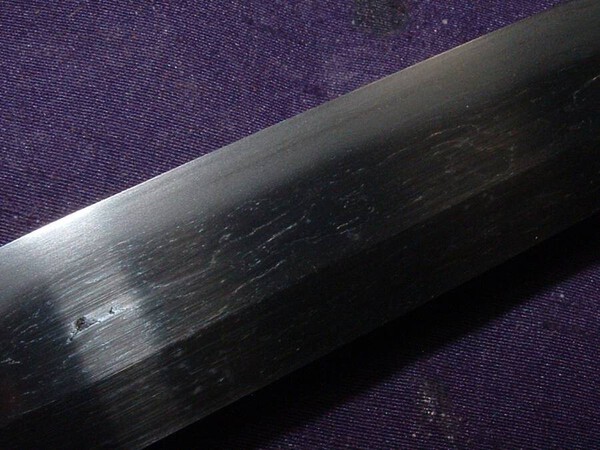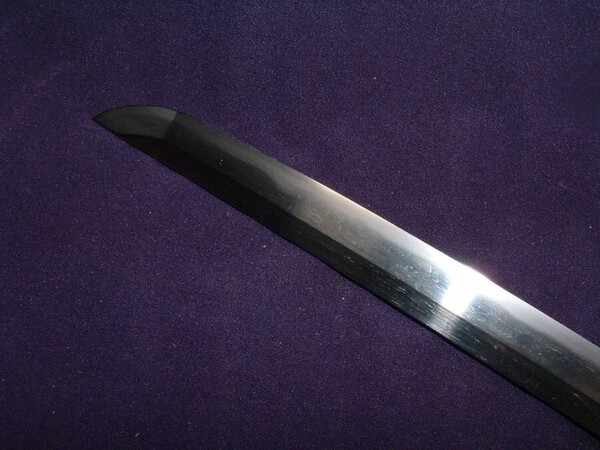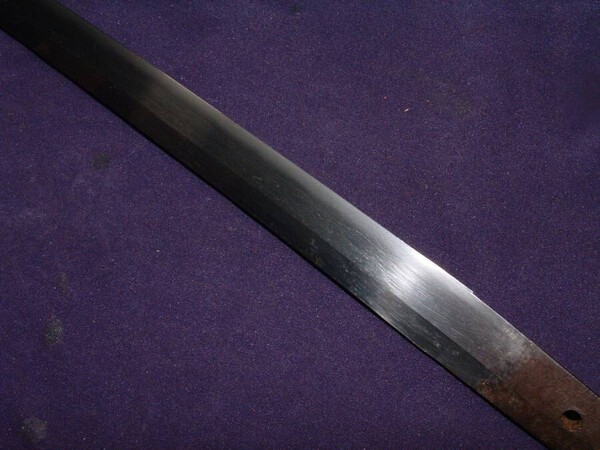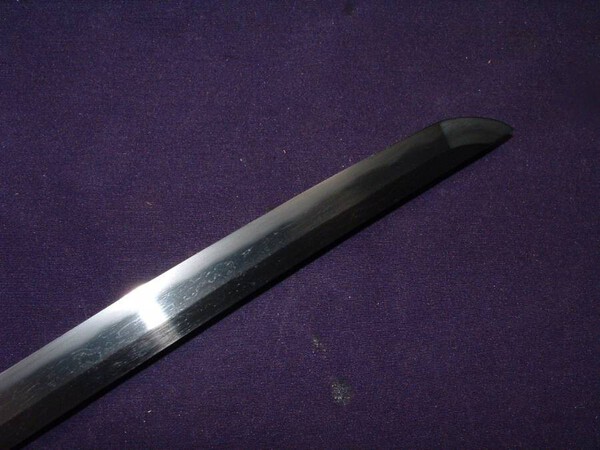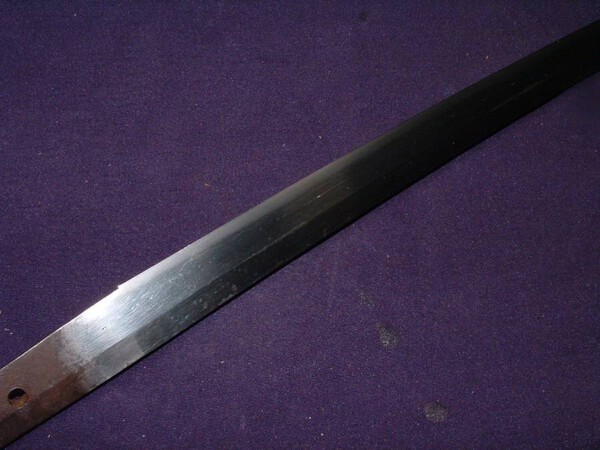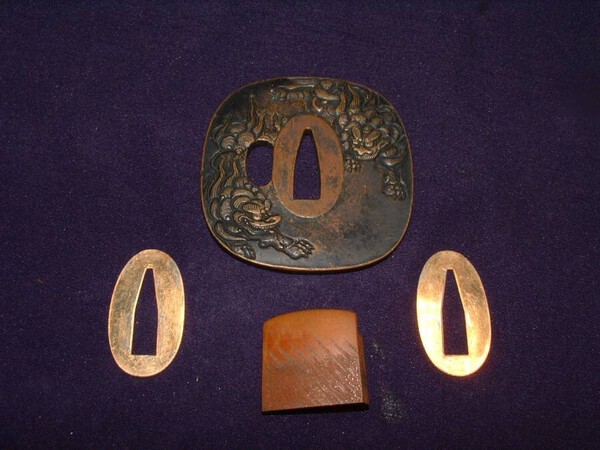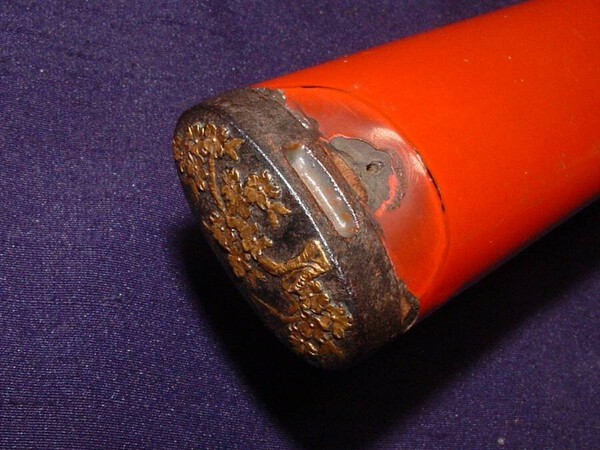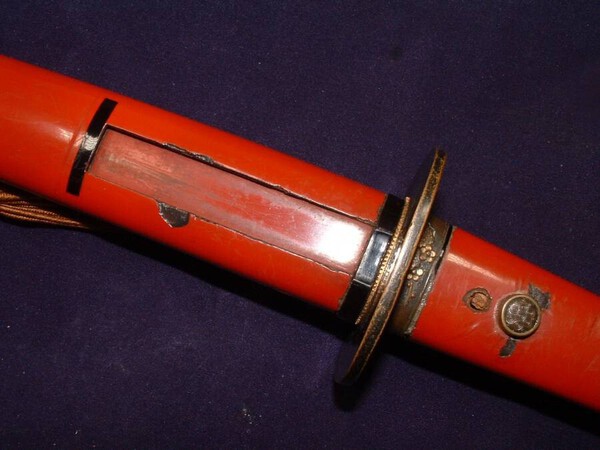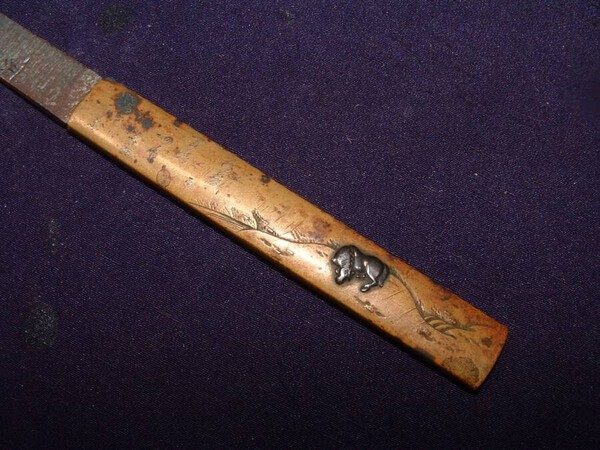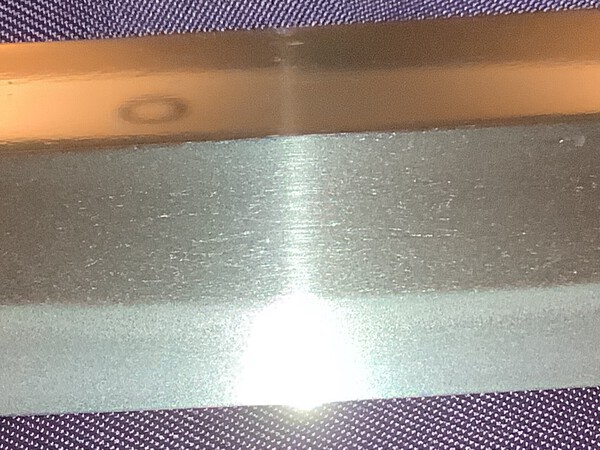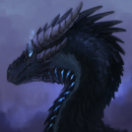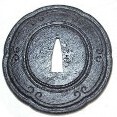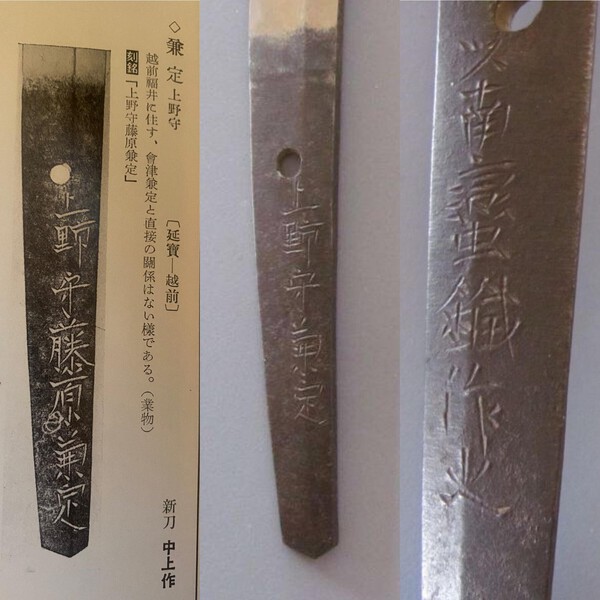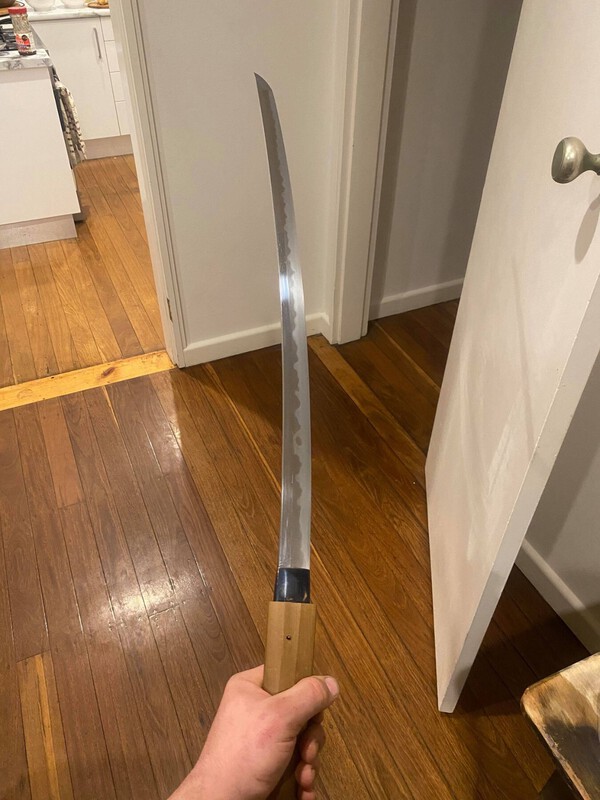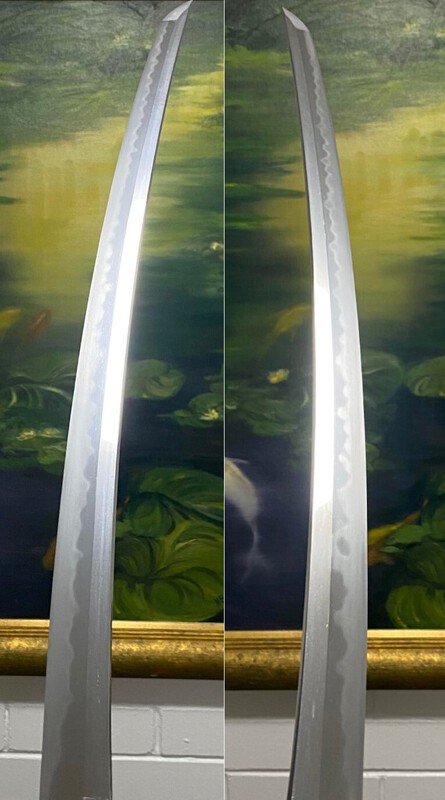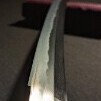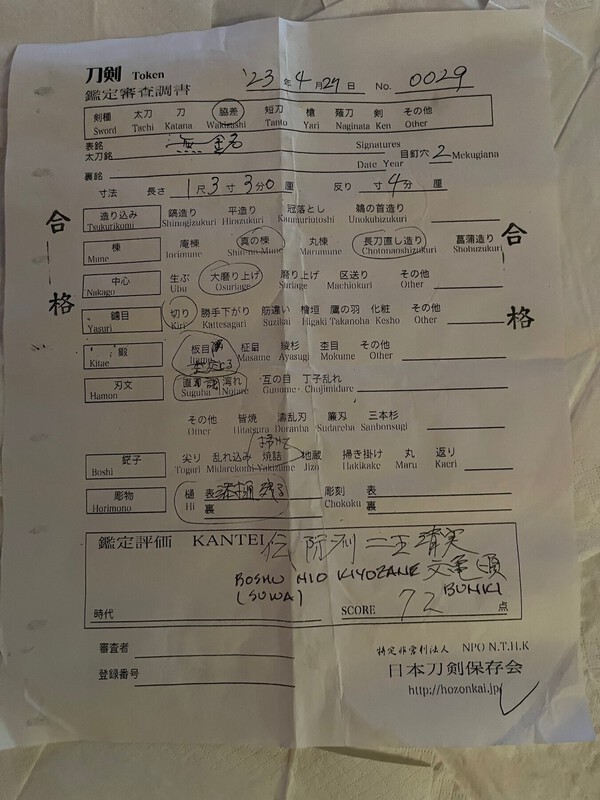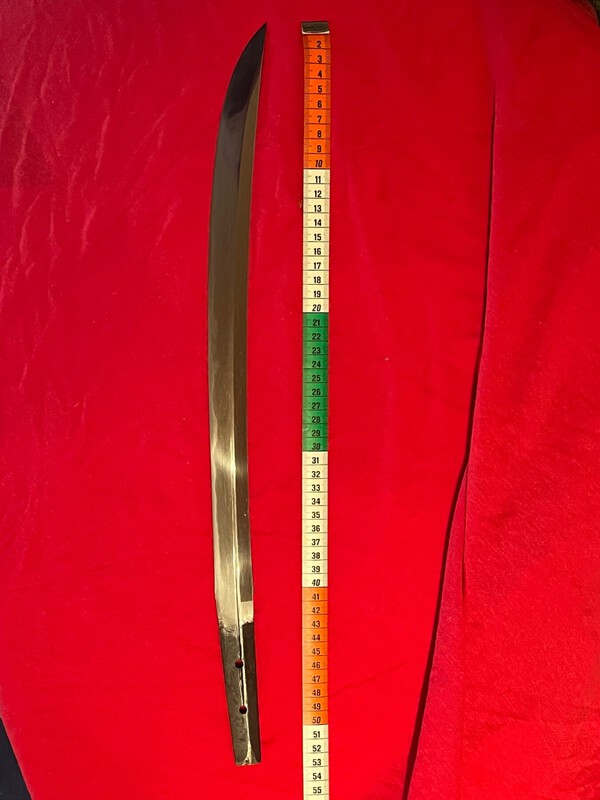Search the Community
Showing results for tags 'wakizashi'.
-
I've been trying to translate the mei on an old Wakizashi my wife's grandpa brought back from WWII. I don't know anything about it and unfortunately can no longer ask where it was acquired as my wife's grandpa is no longer with us. So i am hoping some one here can help me out a little. The research I have done on the translation and looking at other verified swords, it looks kind of like it says Kozuke no kami Kanesada but it isnt an exact match to those either. Can anyone help verify or correct my translation? and also, does this seem to be a genuine piece or is it a later reproduction? I can get some more pictures uploaded later if needed. Thanks, Shawn
-
Firstly, hi I’m new to the group! Recently I purchased this Wakizashi at auction. Here’s what I know Estimated Period: 1603-1868 (Edo Period) Material: Tamahagane Overall length: 61.7 cm Signature: 神田住兼(*)-Kanda ju Ka from what I can make out 神田住兼常 (Kanda ju Kanetsune) Has a certificate (torokusho) from Japan Estimated value by expert €500 - €700 I’m mostly curious to know if the mei is genuine. I have gather some 神田住兼常 (Kanda ju Kanetsune) signatures myself to compare, I will add them to the post aswell. Thanks!
-
Mumei Attribued to Fuyuhiro Period : Late Muromachi Blade Length : 36,2cm Motohaba : 2,9cm Sakihaba : 2,5cm Motokasane : 0,7cm Sakikasane : 0,5cm Weight : 339g Price for group : ̶2̶5̶0̶0̶ $2300 + $50 shipping (with Insurance, from Japan) More and pictures and video available. Don't hesitate to send a message. Fuyuhiro's lineage is rooted in the Muromachi period, with the swordsmith's family moving to Wakasa province, known today as Wakayama. Fuyuhiro was the son of Soshu Hirotsugu, and his craft was held in high regard, forging blades in both Sagami and Wakasa.
-
This Wakizashi is signed by Omi no Kami Fujiwara Tsuguhiro, a skilled student of the third-generation Yasutsugu from Echizen. Mei : Omi no Kami Fujiwara Tsuguhiro Echizen Ju Period : Early Edo Blade Length: 53.2 cm Base Width (Motohaba): 2.8 cm Tip Width (Sakihaba): 1.9 cm Base Thickness (Motokasane): 0.7 cm Tip Thickness (Sakikasane): 0.5 cm Blade Weight: 455 g Hamon: Notare Price for Forum : ̶$3̶5̶0̶0̶ -> $3200 + $50 Shipping (with insurance from Japan) -> More pictures and video available (please send a message).
-
Dear All, I have a table booked at the Birmingham Antique Arms Fair this coming Sunday. I have some swords, tsuba, books, a yari and a sword chest to sell. Prices will be competitive and I'm open to a degree of haggling so please swing by to try to snag a bargain. Alternatively, just drop by and introduce yourselves. I'll add a list of items and prices shortly and if anyone would like further details or photographs please PM me. Hope that's OK with the mods...and as I'm using the forum to plug my sale, a donation will be made. Thanks in advance for looking.
-
Hello NMB, I was directed here by a member for any Nihonto related questions I may have. I’m relatively new to collecting Nihonto, and need help validating the authenticity of, and finding a place to restore for my Wakizashi. I’ve been able to identify the signature as that of Yasuhiro’s. However, I’m aware gimei are rather common, so I’d like to see what you folks think of it. I haven’t translated the kozuka yet, and there happens to be two of them included with this blade (I’m aware that at least one of them happens to be added at a later date). Both kozuka match the color and texture of the kashira and fuchi. Dragons are also displayed across both the kashira and fuchi. The rayskin has a rough/hard texture, and has grown brittle from age. The habaki and tsuba were extremely difficult to remove, as there was a lot of dirt congealed beneath them. The Let me know what you guys think, and if it happens to be a gimei, I’d be interested in how to identify such convincing fakes in the future. The previous owner(s) didn’t reassemble it correctly, and most of the photos taken are before I removed the tsuka, and reassembled it properly. Imgur album: https://imgur.com/a/uNMKrkg
-
Hi there, Ive got a fairly low quality Wakizashi that until recently had a pretty good shine, I probably should have oiled it, but now all of a sudden one side has gone fairly rusty. The sword is not worth enough to get a proper polish, is there any other way, or a guide to remove this surface rust easily? Any help is appreciated, Thanks
- 3 replies
-
- 1
-

-
- wakizashi
- restoration
-
(and 1 more)
Tagged with:
-
Hello group, First time post here. Just trying to get more info about an obscure Maker. Bought this wakizashi a couple years ago and not had much luck learning more about it or it's maker. Had a knowledgeable source tell me it's Kanbun Period and most likely from school Seki in Mino. The Mei reads "濃州住兼品" Noshu Ju Kaneshina? Any information would be greatly appreciated. It did come with kicho white papers but I know those don't mean much these days.
-
I've got a wakizashi that passed Tokubetsu Hozon last year, but on the mune there's what looks like a hairline crack, about 2 inches above the nakago. It's not something that was directly mentioned by the seller, how normal is it / how concerned should I be?
-
Type: Wakizashi Nakago: ubu Mei : Sagami no Kami Hiroshige Papered by the NBTHK to Tokubetsu Hozon Era/Age: Kanbun (1661-1673) Shirasaya, Koshirae or Bare Blade? : Shirasaya Nagasa/Blade Length : Sori : 1.5 cm Hamon Type : notareba Jihada : itame Other Hataraki Visible : Ashi, Yakumo-midare jigane, Ko-nie Flaws : none Sword Location : CO USA Will ship to : most countries Payment Methods Accepted : Zelle, Cashapp, Venmo, Wise, Paypal Price and Currency : $4500 USD More Info: This is a very fine and healthy Soshu blade crafted and signed by the second generation Sagami no Kami Fujiwara Hiroshige (相模守藤原広重), this blade comes from the Kanbun era(1661-1673) in the early Edo Period. The Bushu Shitahara school, where Hiroshige was trained, is in what's now Hachioji city, Tokyo. Founded by Yamamoto Norishige, the school flourished from the late Muromachi to the late Edo period (late 16th to late 19th century). Terushige, a notable pupil of Norishige, taught the first-gen Hiroshige, who then established his lineage in swordsmithing. The second-gen Hiroshige, originally named Yamamoto Fujiemon, was his eldest son. A famous example of this school is the smith Musashitaro Yasukuni. It is an ubu, signed blade, featuring only the original mekugi-ana. It is in good polish, allowing for full view of the blade's craftsmanship. The blade’s activity is extremely striking. The hamon is notareba with very visible ashi in the yakiba. The boshi is very visible as komaru within the surface of the O-kissaki. The itame-hada is well defined and jigane is made up of “Yakumo-Midare” which is the specialty of this group of smiths. The color is a beautiful deep blue when viewing it under direct light. Nagasa: 51.1 cm Sori: 1.5 cm Moto-haba: 3.02 cm Saki-haba: 2.09 cm Kasane: 0.7 cm Accompanying the blade is a well made copper niju-habaki, a well fitting and finely shaped shirasaya, a buffalo horn mekugi, and a velvet colored silk storage bag, and lastly a full oshigata on traditional rice paper.
-
Hello, I recently found a wakizashi as I was cleaning out my grandfather's shop; this item was likely acquired by my great-grandfather when he was stationed in Japan during the Korean War. I am interested in learning more about this item and translating the text that I have found on the sword and its mountings. There is a signature on the tang that I believe is 備州長船住祐定 / Bishu Osafune ju Sukesada. I have searched the Nihonto Club swordsmith index and I found two signatures that match, one from Choroku/Bunmei (https://nihontoclub.com/smiths/SUK781) and one from Horeki (https://nihontoclub.com/smiths/SUK926). I would greatly appreciate a second opinion on this, as well as any further insights anyone can provide. There is also text on the tsuka, but it's hard to make out, even in person. It looks like there is both an ink marking as well as an inscription here. I figured that maybe someone who recognizes the characters might be able to figure out what they are. The scabbard also included a kogai and a kozuka, both of which have text on them. Thank you in advance for your time. I have attached the images in an Imgur link because they exceed the maximum file size allowed; please let me know if you need me to upload these in a different way, or if you need any different pictures / angles. Images: https://imgur.com/a/G5Wntkh
-
So, I'm on my second read-through of The Connoisseur's Book of Japanese Swords. I've read about the length restrictions from other sources before - as Nagayama tells us (it's a shame the book doesn't give the prescribed lengths in shaku etc., as it's less intuitive in metric) So, I have a blade from c. 1660 that has a nagasa of 59cm, so it fits the modern definition of a wakizashi (and this is echoed on the NBTHK certificate), but I'm left wondering: 1. Would this have been worn as a companion sword at the time - or perhaps it just had a shorter owner? 2. Were the length restrictions actually enforced? Could a commoner buy an "over-sized" blade from a reputable smith? Would samurai-class have their blades measured? 3. Any recommendations for documentation sources / further reading about the restrictions, their enforcement and effectiveness (English or Japanese is fine)?
-
Type (Tachi, Katana, Wakizashi, Tanto, Naginata, Other) : Wakizashi Ubu, Suriage or O-Suriage : unknown Mei : (Mumei, Signature) : Mumei Papered or not and by whom? : not papered Era/Age : Edo Shirasaya, Koshirae or Bare Blade? : Koshirae Nagasa/Blade Length : 46cm Sori : 1.5cm, Torii Hamon Type : Midare Jihada : Itame Other Hataraki Visible : unknown Flaws : no fatal flaws observed, see pictures Sword Location : New Hampshire, USA Will ship to : USA Payment Methods Accepted : Venmo preferred, Zelle, PayPal (least preferred) Price and Currency : SOLD usd Other Info and Full Description : more pictures upon request
-
Hello all, I'm back with an update on a wakizashi I acquired a few years ago. I started a thread that can be seen here: to ask about the origins and authenticity of this wakizashi blade. Since then, I have had the blade polished and a shira saya made for it, and i'm basically wondering if any of you more knowledgeable folks on here can offer your opinions on the possible origins of this blade now that more of its features (hamon, hada, boshi, etc) are visible. I was offered a possible explanation for whom the Smith may have been related to, as well as a time era for said Smith, but I'm wondering if the features of the blade align with this info, or if it appears to be from a different time period than previously thought? Thanks a ton for any thoughts you're able to offer 😊 New images of the polished blade can be seen here: https://imgur.com/gallery/N1CslJ3
-
Hi all. New to the forum and to collecting Japanese Swords. A few months ago I bought a Wakishabi which is in a reasonable state of polish but could do with some attention. This weekend I added to my collection a Tanto which was terribly rusty and had been badly scratched with what I assume to have been sandpaper but the guy just wanted to be rid of it as he seemed afraid of it for some reason. I thought the Tanto would be an opportunity to try to learn polishing. I wondered if anyone could read the Mei on either of them.
- 11 replies
-
Hello, I will preface this with the fact that I know basically nothing and have only started to research nihonto over the last 2 weeks or so. Any terms that I use that seem incorrect, probably are. I am looking to get help with researching a wakizashi that has been in the family for a while. I'm not really looking for an appraisal since we wouldn't sell it, but the last couple of generations of my family didn't really know how to care for it or anything. So I'm looking to find out if it's worth getting restored, or just trying to keep it in as good condition as we can right now, or even if there is someone nearby who could help us know how to properly care for it. The history that I know about it is limited. I'm pretty sure that it was brought from Japan to Canada before world war 2 and it was described to me as "the family sword" (with a matching katana). The storage and maintenance has been somewhat neglected for a lot of years in the interim. There was apparently a matching katana, but it was "too big to bring" or something. More recently, it was handed down to my parents. My dad built a glass box to display it (now that I did some research, I now realize, upside down). Since the condition is not amazing and we don't really know what we are doing, none of use are confident enough to remove the handle and see if there are any markings. So my pictures are taken through the glass of the display box. If it looks like there is little black things and the end of the handle and the point of the blade, those are just little plastic hooks holding it up for display. Pictures below. The blade is about 20.5" long, just under 1" wide, handle is just under 5" long. So my questions are: 1. Can anyone help push my research in a certain direction based on these images? 2. Is there anything else that you need to see in order to get better information? 3. Does anyone know someone in the greater Vancouver area who could help me with disassembly/repairs? 4. Is it worth restoring? 5. How does one go about getting something like this restored? I'm assuming that the first google search result for "Sword Restoration Near Me" is not it. I had issues with the images being too big, so I put them all here: https://imageshack.com/a/89oW7/1
-
Hello everyone! I am new to Nihonto, and purchased two Wakizashi, I did the best research I could on them but I would like to hear your thoughts on the maker/time period the blades were forged. And of course if they are authentic. I unfortunately did not have a lot of opportunity to look at Nihonto in my country, as I like in The Netherlands. So I acquired these 2 to kick off my collection. I acquired one from a Japanese seller and the other from a US seller. The one from the US seller came with NBTHK papers. Any information is welcome, I am also quite intrigued by the koshirae on the NBTHK wakizashi. Identified by the seller as signed by Kashu Kiyomitsu saku with NBTHK Kicho Token paper dated 1961.
-
It is a mumei ko-wakizashi, 1 shaku 1 sun (13.6 inches) in a shirasaya it is in good polish and is more beautiful than my pictures can do it justice, the attached picture is to show the hada and a small bit of the hamon, I have more and I will attach them
-
Found this thing on Samurai Museum Shop instagram (https://www.instagram.com/p/ClqgjdZtOOb/) The point of this waki is of some unusual shape. I've never seen something similar before. Has anyone seen something similar? Maybe someone knows how this kind of points are called?
-
I purchased this while it was in quite bad shape and had it restored by Josiah Boomershine. What can you tell me about it? Thanks! Help me identify this wakizashi? https://imgur.com/gallery/AOM4GMl
-
Type (Tachi, Katana, Wakizashi, Tanto, Naginata, Other) : wakizashi Ubu, Suriage or O-Suriage : ubu Mei : (Mumei, Signature) : Kozuke no Kami Kanesada + ura: Motte Namban Tetsu Kore wo Saku Papered or not and by whom? : nbthk kicho (1966) and nbthk tokubetsu kicho (1974) Era/Age : 1600's Shirasaya, Koshirae or Bare Blade? : shirasaya Nagasa/Blade Length : 22 3/4" 57.7 cm Sori : 1.6 cm Hamon Type : notare with O-choji Jihada : tight ko itame Other Hataraki Visible : Flaws : some ware' in shinogi-ji of omote, and small pin prick ware near kissaki Sword Location : australia Will ship to : anywhere Payment Methods Accepted : bank transfer Price and Currency : 3500AUD, or 2200USD Other Info and Full Description : long wakizashi made by Kozuke no kami Kanesada around 1673. sword is also signed on the ura as Motte Namban Tetsu Kore wo Saku, made using nanban tettsu. He was a wazamono smith. I initially purchased this sword from Grey Doffin, and have enjoyed owning it over the past few years, but i'm now narrowing down the styles of nihonto that i collect so i must move this on. I've had this for sale on ebay for a while, and thought id share it with the group. i believe this sword will make a fantastic beginner sword, or even make a nice addition to a collection. Please have a look at the photos, the sword includes shirasaya and two older nbthk certificates, kicho and tokubetsu kicho. Both papers have the same owners name, which is also hot stamped onto the shirasaya. there are also some areas of ware on the blade which i've taken photos of. Sword is located Sydney Australia. Please don't hesitate to ask any questions. may even trade for mihara or hokke.
-
Hello gents, I offer a beautiful Naginata Naoshi Wakizashi, that I currently received back from the NTHK shinsa in Chicago last month. The blade is mumei. The Naginata Naoshi was attributed to Boshu Nio Kiyozane, who worked in the first half of the 15th century around 1440. Here are the measurements: Nagasa: 41cm Nakago Nagasa: 12,8cm Motohaba: 2,7cm Sakihaba: 2,5cm Sori: 1,2cm Motokasane: 0,3cm The workmanship is influenced by Yamato and Soshu den. The sword was originally made as a Naginata, but later shortened to its current length, so it became a Naginata Naoshi with a shobuzukuri construction. The blade has a itame hada mixed with a burl mokume hada, which becomes a straighter Yamato style masame hada through the edge. The hamon is made in suguha notare with a deep nioi guchi of prevalent nie. This complex hamon ends in a beautiful yakizume boshi. Additional activities inside the wakizashi are yabashiri, ji nie, nijuba and inazuma. The overall condition of this sword is excellent to near mint. The old Japanese polish is quite good. There is a larger ware on one side of the blade, but it is nether fatal nor disturbing. This blade comes with a high quality edo period koshirae. The worksheet of the NTHK shinsa is included in this sale. As soon as I receive the kanteisho from Japan, I will send it to the new owner. The wakizashi stays currently with me in Germany and can be shipped worldwide with DHL premium international. My asking price is 2900€ or best offer. Payment should be done via paypal friends and family, or with a transaction directly to my bank account.


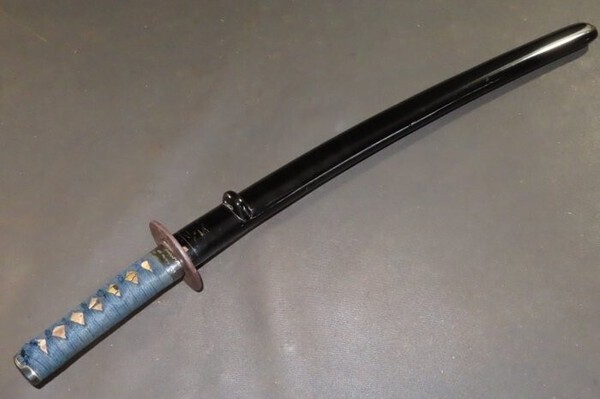
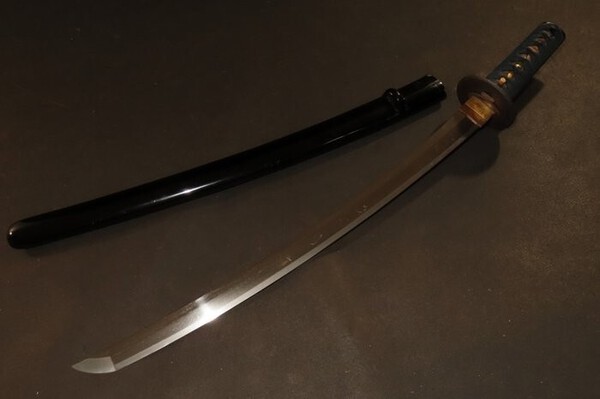
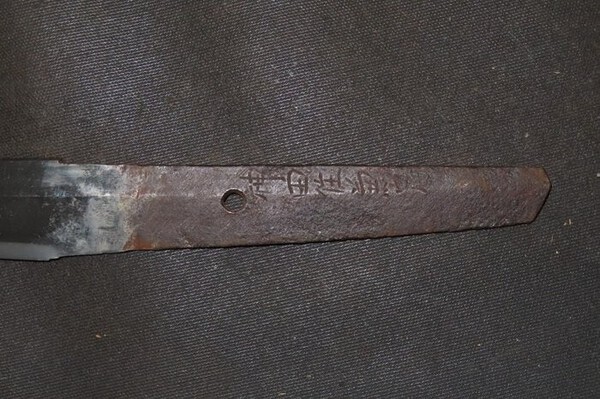
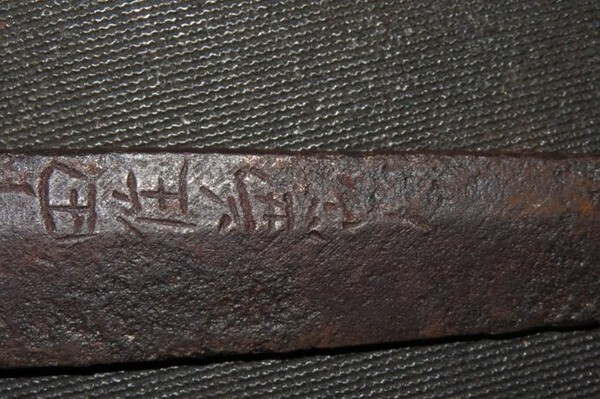
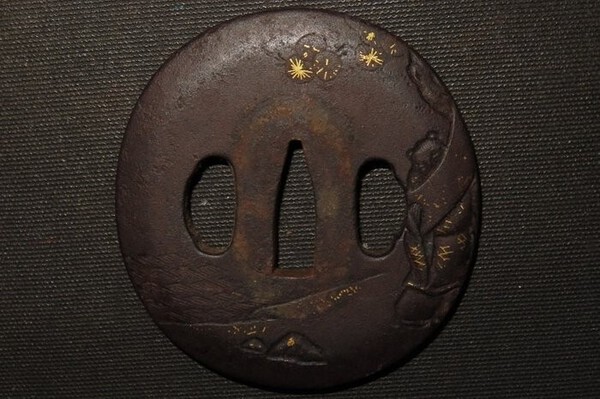
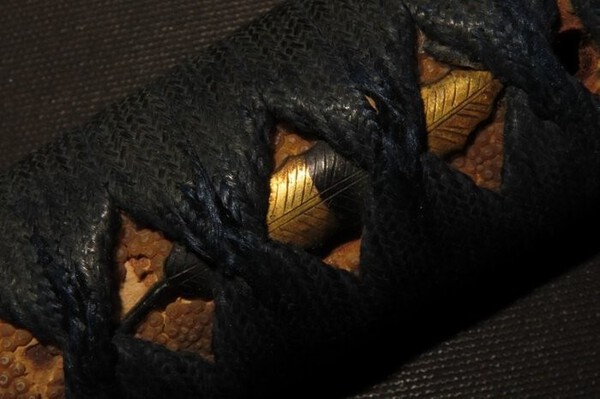
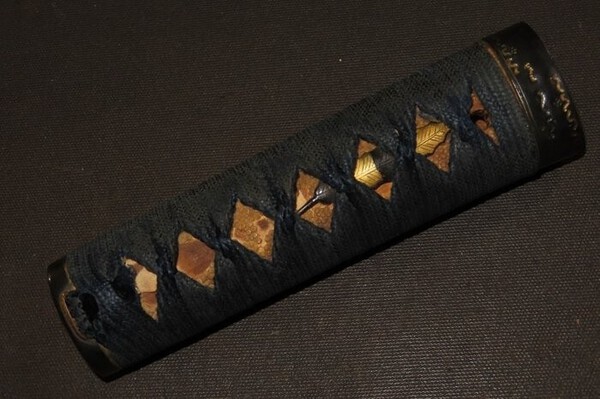
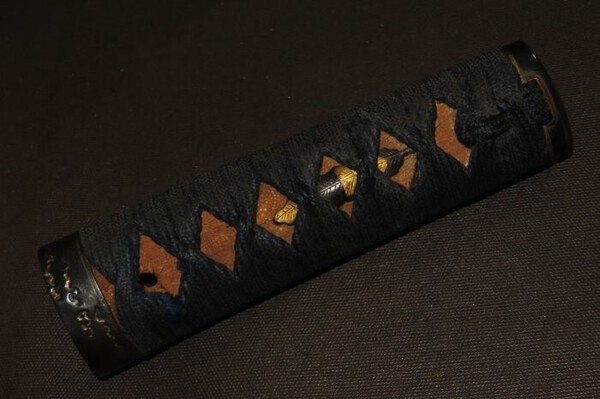
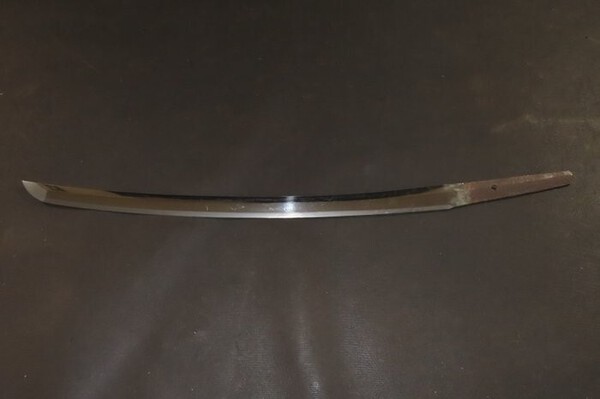
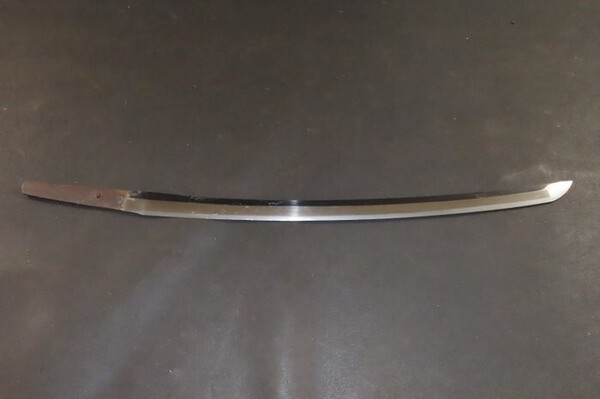
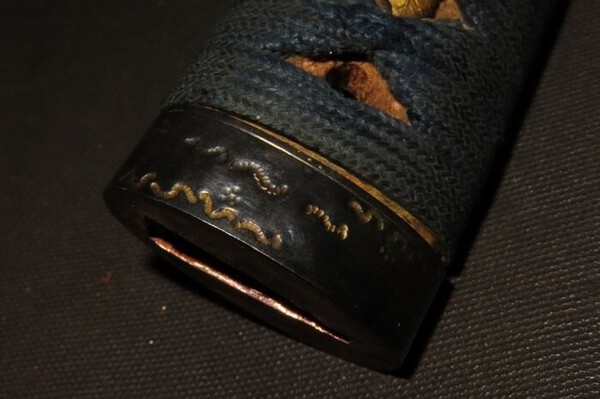
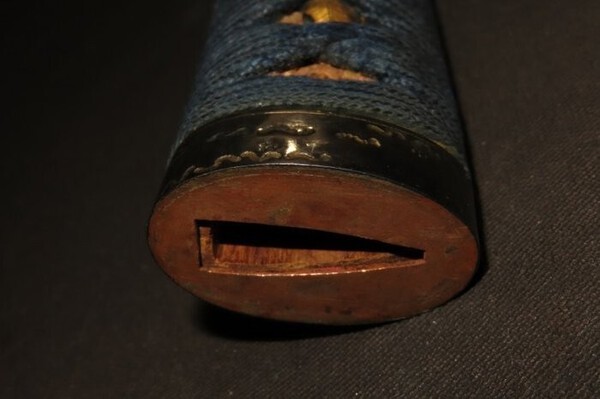
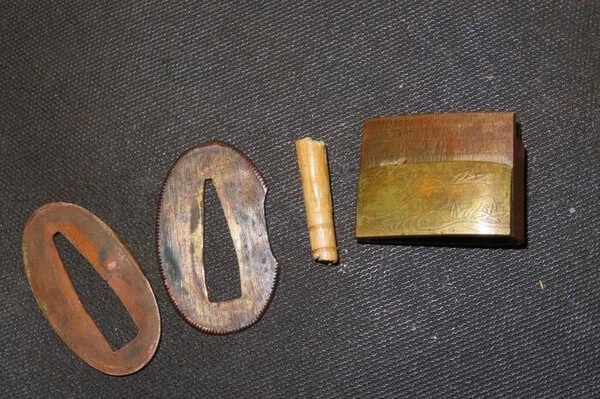
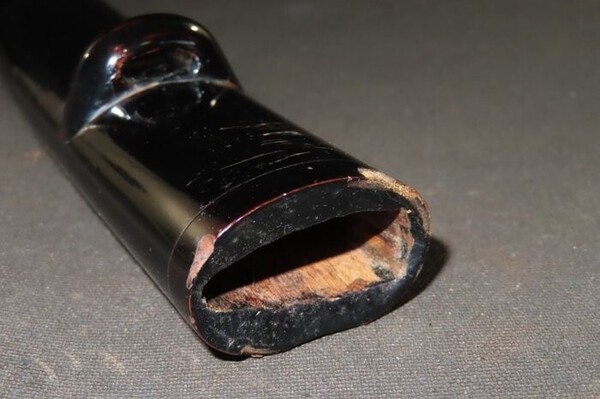
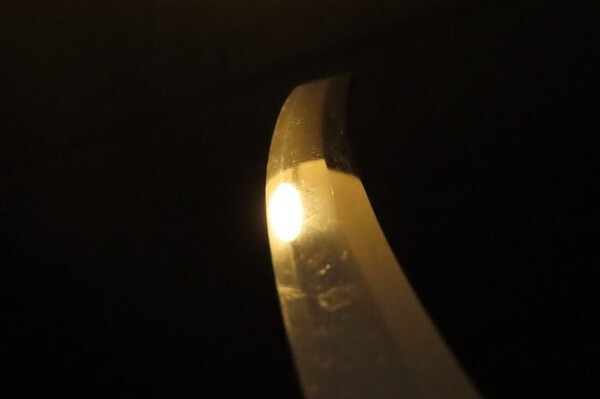
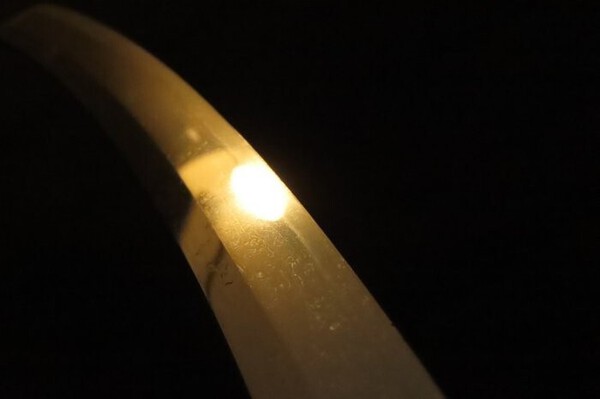
.thumb.png.e17348487d41b00db3268dfd31240746.png)
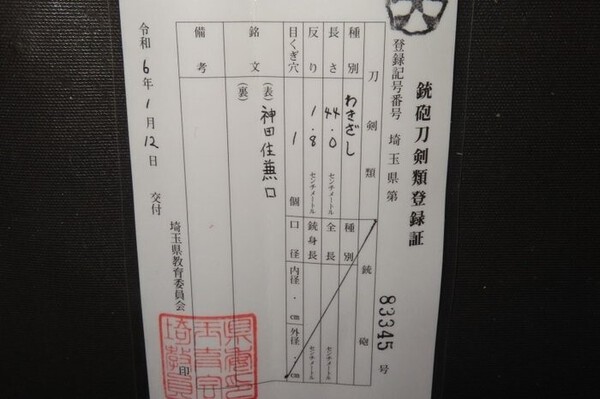



.thumb.jpg.ca912032a9801178b2837ff29b90fbe3.jpg)
.thumb.png.2e9bed00ad6973a8cc549d5d5fa75d24.png)
.thumb.png.75d13bf0d5e8a9d74d336e9593617631.png)
.thumb.png.436b53ef33a4efea123a47f0e0977d0b.png)
(1).thumb.png.e4bd6b58c1c2047fbf836d4600229e3a.png)

.thumb.png.fb0770e65b2ba55fc58e39506e218855.png)
.thumb.png.340a4df01d43b5dcabbae5b09bfd9ae2.png)
.thumb.png.c8deefb6441d66fa028e7934891d5af5.png)
.thumb.jpg.abdc2ac3afc3bb82f2251bf5c35feedf.jpg)
(1).thumb.png.9762f1a5e48f440987302692c9d53dc0.png)



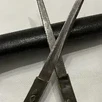

.thumb.jpg.4e89e37cc492793f18c75e4d49f4b453.jpg)
.thumb.jpg.979416a3bbcd93a36c357ae60538492f.jpg)


